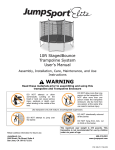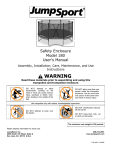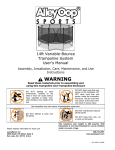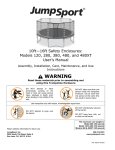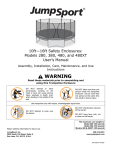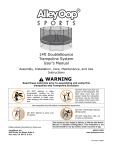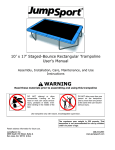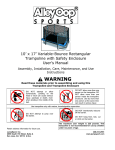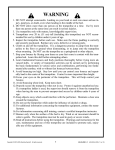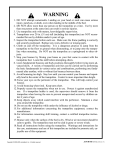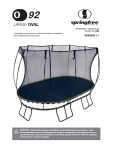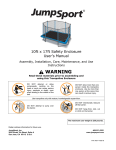Download 10x17 Safety Enclosure User`s Manual
Transcript
10’ x 17’ Rectangular Safety Enclosure User’s Manual Assembly, Installation, Care, Maintenance, and Use Instructions WARNING Read these materials prior to assembling and using this Trampoline Enclosure DO NOT allow more than one person inside the trampoline enclosure. Use by more than one person at the same time can result in serious injury. DO NOT attempt or allow somersaults. Landing on the head or neck can cause serious injury, paralysis or death, even when landing in the middle of the bed. Use trampoline only with mature, knowledgeable supervision. DO NOT intentionally rebound off the barrier. DO NOT attempt to jump over the barrier. DO NOT hang from, kick, cut or climb on the barrier. The maximum user weight is 295 pounds. Retain address information for future use. JumpSport, Inc. 2055 South 7th Street, Suite A San Jose, CA 95112 U.S.A. 408-213-2551 www.jumpsport.com 1 Copyright Notice This material is protected by the United States copyright laws and is proprietary to JumpSport, Inc. Disclosure, reproduction, translation, modification, or use of this document by anyone other than authorized employees, authorized users, or licensees of JumpSport without the prior written consent of JumpSport, Inc. is prohibited The information in this document is subject to change without notice. JumpSport, Inc. shall not be liable for any damages resulting from technical errors or omissions, which may be present in this document, or from use of this document. Copyright © 2005, by JumpSport, Inc. All rights reserved Printed: 2005 Version 1.0 Instruction Manual P/N: TR-INS-J-0856 Revision 2 10’x17’ Rectangular Safety Enclosure P/N: JS-JC-0120 Trademarks JumpSport®, Proflex Basketball Set™, Game and Party Pak™, SureStep™ Trampoline Ladder, and BounceBoard Extreme™ are trademarks of JumpSport, Inc. All other brand or product names are trademarks or registered trademarks of their respective companies or organizations. Patents This product includes technology associated with one or more of the following U.S. Patents: No. 6,053,845 No. 6,261,207 No. 6,840,891 No. 6,846,271 Additional Patents Pending. How to Contact Customer Support Should you require customer service or technical support for your 10’x17’ Rectangular Safety Enclosure, please contact JumpSport’s Customer Service department at: 408-213-2551 8:00am—5:00pm Monday through Friday, Pacific Time 2 Contents Chapter 1 Introduction 5 JumpSport Proflex Basketball Set Game and Party Pak Chapter 2 Chapter 3 Assembly and Installation Instructions 7 Preparation Trampoline Placement Tools Parts List Assembly Final Steps Disassembly 7 7 8 8 10 21 21 Care and Maintenance Instructions Inspection Cold Weather Protection Replacement Parts Disassembly Care and Maintenance Safety Checklist Windy Conditions Moving the Trampoline Care Chapter 4 Warning Information Points of Safety Before you Jump, Read this: Landing on Springs or Frame Bouncing off the Trampoline Landing Incorrectly on the Mat Chapter 5 6 6 Use Instructions 23 23 23 23 23 24 25 25 25 27 27 27 28 28 28 29 Safety Rules Basic Skills Bouncing Stop Bounce Arm Action Bounce Variations Basic Landing Positions Seat Drop Hands and Knees Drop Front Drop Series of Drops Twisting Moves Swivel Hips Turntable Twist Variations 29 30 30 30 30 31 31 31 32 32 33 33 33 34 34 Warranty Information 3 Last Page (This page left intentionally blank.) 4 Introduction 1 Congratulations on purchasing a JumpSport Safety Enclosure! We sincerely believe that you have purchased the safest trampoline enclosure on the market. It has been engineered with safety, durability, and performance in mind. Safe use of a trampoline, with or without a safety enclosure, also requires adequate knowledge of technique, as well as what not to do. Please read this manual thoroughly for key points of safety. Trampolines, being rebounding devices, propel the performer to unaccustomed heights and into a variety of body movements. Therefore, it is emphasized that all purchasers, and all persons using the trampoline, become familiar with the rules for safe use. Misuse and abuse of this trampoline is dangerous, and can cause serious injuries. The purchaser/ user of this piece of equipment is assuming a degree of risk for which JumpSport cannot be responsible. Read this information thoroughly before allowing the trampoline to be used. Keep this manual available for your review, and for review by all potential users. If there are questions please call JumpSport for further explanation. Caution Many users of our trampolines are children, and therefore need close supervision and rules to follow while playing on the trampoline. These rules must be enforced by whomever is responsible fore the care of the children. It is strongly recommended that the buyer of this product go over the rules and recommendations in the packet of information supplied, including those in this manual. It is also strongly recommended that these rules and recommendations be supplemented with those of your own, for example: the time that jumping is allowed, when neighbors can visit, and so on. These rules and recommendations should be reviewed with anyone who is going to jump on the trampoline. If it is possible, review these rules with the parents or guardians of any visitors who may be jumping on the trampoline. See Safety Rules on page 29 for more information. 5 Introduction JumpSport Proflex Basketball Set Let’s face it, kids have to look up a lot: at parents, teachers, and bigger brothers/sisters. With the JumpSport Proflex Basketball Set, look down for a change! Whether you are into practicing your outside shot or improving your up-close game, the Proflex Basketball Set is a fun way to avoid homework. Heck, athletic scholarships pay for college too! • Our most popular accessory! • Easily installed to your safety enclosure • Set includes basketball Don’t miss out on these fun accessories and more at www.jumpsport.com ! Game & Party Pak Bring the party to your trampoline! The Game & Party Pak is a great way to take turns and have fun participating in games while you are waiting. Set Includes: Convince your parents that games provide the “structure" you need in your life, and that the Game & Party Pak is just the solution. Plus, you can tell them the Party Pak does big words like: • Enhances Athletic Building Blocks • Develops Agility, Stamina, Balance, Coordination • Improves Spatial Awareness (They won’t be able to turn you down.) 6 • Illustrated book of 20 games • 3 soft balls • 4 shock cords • 1 box of sidewalk chalk • Hours of fun! Assembly and Installation Instructions 2 This chapter covers the following topics: Preparation..................................................................................................................................................................................7 Assembly....................................................................................................................................................................................10 Disassembly ..............................................................................................................................................................................20 Preparation Before you begin assembling your 10’x17’ Rectangular Safety Enclosure, make sure your trampoline is in a good location. Trampoline Placement Caution: When deciding on where to place your trampoline, consider the following: WARNING Overhead Clearance Adequate overhead clearance is essential. A minimum of 24 feet from ground level is recommended. Provide clearance for wires, tree limbs, and other possible hazards. Lateral Clearance Lateral clearance is essential. Place the trampoline and trampoline enclosure away from walls, structures, fences, and other play areas. Maintain a clear space on all sides of the trampoline and trampoline enclosure. Level Surface Place the trampoline and trampoline enclosure on a level surface before use. Lighting Use the trampoline and trampoline enclosure in a well-lighted area. Artificial illumination may be required for indoor or shady areas. Security Secure the trampoline and trampoline enclosure against unauthorized and unsupervised use. Underneath Clearance Remove any obstructions from beneath the trampoline and trampoline enclosure. Note: The trampoline enclosure is only to be used as an enclosure for a trampoline and the trampoline must be of the appropriate size as covered by the specific enclosure. Note: The owner and supervisors of the trampoline are responsible to make all users aware of practices specified in the Use Instructions. It is the responsibility of the purchaser to become familiar with all of the information in this booklet, to convey the warnings to all users, and to enforce JumpSport’s rules for safe use. This unit is not intended for commercial or public use and is therefore strictly prohibited. The maximum user weight is 295 pounds. 7 Assembly and Installation Instructions Tools Installation requires a 1/2-inch wrench and an Allen wrench, both of which are included with your enclosure (see Ref. #8 and #9 in the list below). An 8 foot A-Frame Ladder will be useful for some Steps (use care and follow procedures for use). Safety glasses and gloves are recommended. Parts List Your 10’x17’ Rectangular Safety Enclosure is shipped with the parts shown below. The enclosure ships in one box, but has a smaller box inside of it (labeled as “internal carton”). See the far right column for the contents of each box. If any parts are missing, please call JumpSport Customer Service at 408-213-2551. Note: Do NOT discard the foam tubing (Reference #3 and #4), as it is used as part of the pole assemblies. It is not just packing material. Do NOT remove any caps from the ends of any of the support poles. Document bag Tool bag Bolt bag Eyebolt bag Strap & Buckle bag Reference # Part # 1 SE-POL-J-0857 2 SE-POL-J-0858 3 SE-FOA-KX-0833 4 SE-FOA-KX-0832 5 SE-WRN-J-0076 6 SE-CAB-X-0017 7 XX-PUR-J-0073 8 XX-TOO-X-0883 9 XX-TOO-X-0884 10 11 SE-NET-X-0787 SE-CAP-X-0019 12 13 14a 14b 14c 14d 15a 15b 15c 15d 16 TR-FOA-X-0968 SE-SLE-J-0897 SE-BOL-X-0827 XX-WAS-X-0879 SE-SPA-X-0828 XX-NUT-X-0880 SE-EYE-X-0026 SE-CAP-X-0388 SE-NUT-X-0391 SE-NUT-X-0462 SE-BUN-KA-0165 17 SE-BUN-X-0887 18 SE-BUN-X-0889 19 20 SE-STR-X-0647 SE-BUC-X-0012 21 SE-BUN-X-0646 Description Quantity Box # Support pole, upper 8 main box Support pole, lower, with snap-button 8 main box Short foam tubing (2 tubes packed over 1 pole) 8 main box Long foam tubing (1 tube packed over 1 pole) 8 main box Warning Placard 1 main box (bag) Cable Tie 2 main box (bag) Registration Card 1 main box (bag) Wrench, fits 1/2" hex nuts 1 main box (bag) Wrench, Allen 1 main box (bag) Heavy duty safety net 48 feet long 1 internal carton Ball end cap 8 internal carton Very short foam tubing 6 inches long 8 internal carton Foam sleeve, blue vinyl 8 internal carton Bolt, 1/2" Allen head 16 internal carton (bag) Washer (for bolt) 32 internal carton (bag) Pole spacer, black (for bolt) 16 internal carton (bag) Nylock acorn nut, 1/2" capped end (for bolt) 16 internal carton (bag) Eyebolt, 1/2" 8 internal carton (bag) Eyebolt cap, plastic (for eyebolt) 8 internal carton (bag) Nylock nut, 1/2" (for eyebolt) 8 internal carton (bag) Acorn nut, 1/2" capped end (for eyebolt) 8 internal carton (bag) Bungee T-anchor 13 internal carton (bag) Short bungee cord, hook at each end 76 inches long 2 internal carton (bag) Long bungee cord, hook at each end 10 feet long 2 internal carton (bag) Pole strap, loop at one end 13 feet long 8 internal carton (bag) Slide buckle, black plastic 1 internal carton (bag) Long bungee cord, loop at each end 86 inches long 8 internal carton (bag) 8 Assembly and Installation Instructions The following pages contain diagrams, pictures, and written instructions. The diagrams and pictures label each part, show how they fit together, and indicate which Step that part is used in. The “Ref. #” mentioned in most of the Steps, is referring to the “Reference #” column of the parts list on the previous page. The diagrams and pictures on the left-hand pages correspond with the written instructions on the right-hand pages. For installation questions, please contact JumpSport’s Customer Service department at: 408-213-2551 8:00am—5:00pm Monday through Friday, Pacific Time Please fill out and mail us the Registration Card (Ref. #7) after completing the installation of your 10’x17’ Rectangular Safety Enclosure. Caution: Do not hold any pole support pieces by the tapered end when connecting them to an adjoining section. Be sure that there is nothing between the pole assemblies and the adjoining vertical leg pieces (other than the pole spacers, see Pictures C and D) when installing the pole assemblies. Failure to use caution may result in severe pinching or cutting. 9 Diagram 1 Diagram 2 Step 1 Step 2 Upper support pole, Ref. #1 Lower support pole, Ref. #2 Very short foam tube Ref. #12 (snap-button) Lower pole Upper pole Short foam tube Ref. #3 Diagram 3 Step 3 Eyebolt, Ref. #15a Foam sleeve Ref. #13 Eyebolt Cap, Ref. #15b Ball End Cap Ref. #11 Slide ball end cap over top of pole, then connect eyebolt assembly. Hole in leg socket of trampoline rail Hole in vertical leg piece, shown with indentation facing out Long foam tube Ref. #4 Nylock Nut, Ref. #15c Acorn Nut, Ref. #15d (Both holes shown correctly lined up with each other. Visible holes are on outside of trampoline, facing away from the center.) Step 5 Picture B Step 4 Picture A 10 (Picture showing pole being installed on long rail piece with truss. Poles are installed on the outside of the vertical leg pieces.) Assembly and Installation Instructions Assembly Note: We recommend at least 2 people participate in assembling the safety enclosure. Use pages 8–10 to help with part names and numbers, as well as locations for each piece. 1 Create one pole assembly by inserting the small end of a lower support pole (Ref. #2) into the large end of an upper support pole (Ref. #1). When done correctly, the snap-button on the lower pole will lock into the hole on the upper pole (see Diagram 1). 2 Slide a long foam tube (Ref. #4), a short foam tube (Ref. #3), and a very short foam tube (Ref. #12) onto the pole assembly. The long foam tube goes at the bottom of the pole assembly, the short foam tube goes in the middle, and the very short foam tube goes at the very top of the pole assembly. Slide a foam sleeve (Ref. #13) down over all the foam pieces, starting at the top of pole (see Diagram 2). Slide the sleeve down until there is approximately 4 inches of pole showing at the top. If the sleeve does not completely cover the very bottom of the long foam tube, push all of the foam up into the sleeve as high as you can. 3 Place a ball end cap (Ref. #11) on top of the pole assembly. Rotate the cap so that the holes in the cap align with the holes in the top of the pole assembly. Slide an eyebolt (Ref. #15a) through an eyebolt cap (Ref. #15b), and then slide the eyebolt through the holes in the ball end cap and the top of the pole (see Diagram 3). Hand-tighten a Nylock nut (Ref. #15c) onto the threaded end of the eyebolt. Slide the foam sleeve and foam tubes up under the ball end cap as far as they will go. >> Repeat Steps 1-3 for remaining support poles (there will be a total of 8 pole assemblies when complete). 4 Make sure that the holes in the vertical leg pieces of each leg assembly line up with the holes in the leg sockets, and that the indentations in the vertical leg pieces are facing away from the center of the trampoline. If the holes are not lined up, twist the vertical leg pieces until the holes line up with each other (see Picture A). 5 Have one person lower a pole assmebly down along the length of a vertical leg piece (see Picture B) and hold it near each of the holes described in Step 4. Each pole assembly will mount on the outside of each vertical leg piece. Note: The eyebolt hook at the top of each pole must be facing outward, away from the center of the trampoline. A second person should secure the pole to the leg and leg socket using an Allen bolt (Ref. #14a), washer (Ref. #14b), pole spacer (Ref. #14c), and Nylock acorn nut (Ref. #14d). Tighten all bolts snugly. See Pictures C and D, below, for details. >> Repeat for all remaining pole assemblies (total of 8 poles attached). Note: When properly installed, there should be no exposed threads on any of the bolts. One pole has a warning label at the bottom of the pole. The label should be visible when the eyebolt hook faces outward. Washer Ref. #14b Pole spacer Ref. #14c Nylock acorn nut Ref. #14d P = Pole assembly Bolt Ref. #14a L P P Washer Ref. #14b L = Vertical leg piece Picture C Picture D 11 Net Ref. #10 If necessary, untie knots at this end, stretch net to 48 feet, and re-tie to the edge of the net. 48 feet Edge of the net Bottom strap of net Diagram 4 Knot Step 6 Pole 5 Pole 4 Pole 3 8-10 X’s on end. Pole 6 View of net when hung (dashes indicate straps) (Poles are numbered in order to clarify orientation for assembly.) Pole 7 15 X’s on sides. Pole 8 6-8 X’s at inner panel of net. Pole 2 (Finish) Pole 1 (Start) (End of trampoline that has warning placard.) 4-6 X’s at outer panel of net. Diagram 5 (Top View) Step 8 12 (Net X’s are on top strap of net. Number of X’s are approximations only.) End with loops Assembly and Installation Instructions 6 Find an area (approximately 50 feet) to straighten out the net (Ref. #10). With one person at each end, shake and pull the net so that the net gets unravelled and is stretched to its full length (see Picture E, right). The net should measure approximately 48 feet from edge to edge (see Diagram 4). If the net measures less than 48 feet, loosen the knots in the support straps at the end of the net without loops. Slide the net to 48 feet then tighten the knots so that the net will not slide along the support straps. 7 Find the end of the trampoline that has the warning placard hanging from it. (It should be hanging from one of the short ends of the trampoline if the trampoline assembly instructions were properly Picture E followed.) If the net has a support strap that is wider than the other strap, be sure the wider strap is located at the top edge of the net. Then find the end of that strap that has a loop, and place the looped end over the ball end cap at pole 1. Place the loop into the eyebolt hook. The hook on the eyebolt must be pointing up toward the top of the pole (see Diagram 6, below). Diagram 6 Ball end cap at pole 1 Note: Check to be sure the eyebolts on each pole are facing away from the center of the trampoline, that the eyebolt hooks are pointing up toward the top of each pole, and (if applicable) the wider support strap is at the top edge of the net, 8 Pull the net to the outside of pole 2. With tension on the net, hook the support strap and a mesh of net into the eyebolt hook, so it will maintain its position. Along the top support strap, you will see the net itself making X’s along the strap (see Picture F, below right). If you stand on the inside of the trampoline and look up at the top strap, you will be able to count the number of X’s that show, in between each pole: • • • • At the end of the trampoline with the overlapping doorway (between pole 1 and 2), the inner panel of net should have approximately 6-8 X’s showing. There should be approximately 15 X’s showing, in between poles 2 and 3, poles 3 and 4, poles 4 and 5, poles 6 and 7, poles 7 and 8, and poles 8 and 1. At the short end of the trampoline (opposite the overlapping doorway), there will be approximately 8-10 X’s showing. At the end of the trampoline with the overlapping doorway (between pole 1 and 2), the outer panel of net should have approximately 4-6 X’s showing. Continue hanging the net on the outside of all the remaining poles (including pole 1 again), clockwise around the trampoline. See Diagram 5 for details. The net will sag (hang very loosely) between each pole. This is normal. Picture F Note: Net is hung on the outside of the poles. The number of X’s suggested are approximations only. If you find that you end up with too many or not enough X’s after hanging the entire net, go back and make minor adjustments, keeping each section of net on the long sides of the trampoline consistent with each other. 13 Picture G Picture H Step 6 Pad skirt shown hanging (top picture) then shown tucked under (bottom picture) Step 6 Pad skirt shown hanging (top picture) then shown being tucked under (bottom picture) Diagram 7 Diagram 8 Step 13 Inner panel of net Loop on bottom strap is connected to V-ring on trampoline mat, using a bungee T-anchor. Step 14 Pole 2 (Trampoline pad.) Pole 1 Pole 1 Lower support strap on outer panel of net ties off at pole 2. (Trampoline spring pad not shown for clarity. Pad would normally be installed.) 14 Outer panel of net Assembly and Installation Instructions 9 Once the top of the net has been connected to each of the 8 eyebolt hooks, pull the top strap to take any slack out of the top of the net (so that it does not sag in between any of the poles). It will require 2 people to take all of the slack out of the net: 1 person to keep tension at the very end of the net, and the other person to go around to each section of net and feed the slack through. If done correctly, the bottom of the net will not reach the trampoline mat in many areas and the top of the net will no longer sag. 10 After pulling the top strap to remove any slack, you will need to untie the knot holding the top strap in place. Pull the slack through, and retie the knot on the top strap. Diagram 9 Slide Buckle 11 After going clockwise around the trampoline - hanging the net on the outside of all the poles - you will be back at pole 1. Pull the net and top strap to pole 2, and form a loop in the strap by installing the slide buckle (Ref. #20. See Diagram 9, left). Slip the loop over the ball end cap on pole 2, and secure it in the eyebolt. If there is any excess strap hanging down, gently wrap it a few times around pole 2, and tie it off near the bottom of the pole. Pole 2 12 The skirt of the pad will be hanging down between the middle poles on each side of the trampoline. Tuck the skirt of the pad up underneath the pad, so the skirt is wedged between the bottom of the pad and the rail of the trampoline (see Pictures G and H). 13 Attach a bungee T-anchor (Ref. #16) around the looped end of the lower support strap (this is on the inner panel of netting, see Diagram 7). Feed the plastic “T” through the notch in the pad and through the visible V-ring (see Diagram 10, below). The T-anchor will be installed to the inside of the trampoline pad. Note: If there is any slack in the bottom support strap between pole 2 and the T-anchor you just installed, remove the T-anchor and attach it to the corner of the net instead of to the loop in the strap. Then reattach the T-anchor to the V-ring. This should remove any extra slack in the bottom of the net. Bungee T-anchor V-ring Diagram 10 14 Pull the other lower support strap (on the outer panel of netting) toward pole 2 until the edge of the net is nearly vertical. Wrap the lower strap around rail of trampoline two or three times, tie the strap securely to the trampoline rail, then wrap the excess strap around the rail toward pole 2. Tie the very end of the strap off at the rail or at pole 2 (see Diagram 8). 15 “Hour-glass” shape. Minimum of 8 inches of overlap in the middle. Diagram 11 Diagram 12 Step 15 (Top View) Steps 16 & 17 Pole 3 C Pole 4 C T Pole 2 T T C= Bungee T-anchor at corner (on long side of rail) Bungee T-anchor at inside panel of net T= T Pole 1 Bungee T-anchor at notch in pad The strap on the bottom of the net may not line up directly over the notches and corners of the pad. You may have to pull the support strap at the bottom of the net toward each notch and corner before securing the T-anchor. T C Pole 5 T (Not used) T Pole 6 T Pole 8 Pole 7 Step 18 - 20 Step 18 - 20 Picture I Picture J 16 C (Wrap around strap only. Do not wrap around netting.) Assembly and Installation Instructions 15 When hung correctly, the inner and outer panel of net should overlap by 1 to 3 feet (minimum of 8 inches in the middle, due to the “hour-glass” shape). See Diagram 11 for what the hour-glass shape should look like. Note: If the net does not overlap by at least 8 inches in the middle of the net, be sure your net measured 48 feet (see Step 6). Also, go back to Step 8 and recount the number of X’s along the top of the net. 16 Pull the bottom of the net down each pole. Attach a bungee T-anchor around the bottom support strap at every location around the trampoline where the pad has a notch in it (similar to the notch described in Step 13). See Diagram 12 for T-anchor locations. Feed the plastic “T” through the notch in the pad and through the visible V-ring. The T-anchor will be installed to the inside of the trampoline pad. (Total of 8 locations at pad notches, 2 on every side of the trampoline.) Note: The strap on the bottom of the net may not line up directly over the notches in the pad. You may have to pull the support strap at the bottom of the net toward each notch before securing the T-anchor. Picture K 17 Attach a bungee T-anchor around the bottom support strap at each corner of the trampoline. See Diagram 12 for T-anchor locations. There will be no notch in the pad, but lift the edge of the pad and feed the “T” through the corner-most V-ring on the long side of the trampoline mat (see Picture K). The T-anchor will be installed to the inside of the trampoline pad. (Total of 4 locations, 1 at each corner.) Note: The strap on the bottom of the net may not line up directly over the corners of the pad. You may have to pull the support strap at the bottom of the net toward each corner before securing the T-anchor. 18 At the middle of each long side of the trampoline (where you tucked the skirt up under the pad, in Step 12) connect a long bungee cord with hooks at each end (Ref. #18) around the pole and rail piece (see Picture I). Then wrap the bungee cord around the bottom support strap of the net and around the rail (see Picture J). Keep wrapping it around the strap and rail until you get to the next pole. Then secure the end of the bungee around the pole and rail piece in the same way that you initially secured it (see Picture I). Note: Wrap the bungee around the bottom strap only. Do not wrap it around the net itself. 19 Now go to the middle of the short end of the trampoline (the end opposite the overlapping doorway) and connect a short bungee cord with hooks at each end (Ref. #17) around the pole and rail piece. Wrap the bungee around the bottom strap and rail, and connect the bungee to the pole and rail, exactly like you did in Step 18. Note: Wrap the bungee around the bottom strap only. Do not wrap it around the net itself. 20 Now go to the middle of the short end of the trampoline (the end with the overlapping doorway), and again, attach the net in the same way as you did in step 18, except that the outer panel of net will not extend all the way across the short rail piece. Continue wrapping the short bungee cord around the rail until you get to the next pole, then secure it exactly like you did in Step 18. Note: Wrap the bungee around the bottom strap only. Do not wrap it around the net itself. 17 Step 21 Step 21 Picture M Picture L Diagram 13 Diagram 14 Step 22 Step 23 View from outside of trampoline Long Bungee Cord Ref. #21 Connect long bungee cord to pole by feeding one end through the other. Weave pole strap (Ref. #19) through every other inside loop of bungee cord. Do not weave the pole strap through the net itself at any point. Weave the bungee cord vertically through every 3rd mesh of net, and install loop over ball end cap. 18 Assembly and Installation Instructions (Safety Enclosure) 20 Inspect the top of a pole. Make sure that the upper support strap and a mesh of net are seated into the eyebolt hook, and that the eyebolt hook is pointing up. Tighten the Nylock nut with the 1/2” wrench (Ref. #15 on page 8) so that the eyebolt hook becomes flush with the eyebolt cap. Hand-tighten an acorn nut (Ref. #15d) onto the end of the eyebolt (see Diagram 15, right). Tighten the acorn nut as tight as you can using only your hand (do not use the wrench). >> Repeat at all remaining poles (8 total). Eyebolt hook pointing up, Note: When properly installed, there should be no flush with exposed threads on any of the eyebolts. eyebolt cap. Nylock nut Ref. #15c Acorn nut Ref. #15d 21 On the underside of each of the spring pads, the straps should hang straight down next to the spring. Diagram 15 (This is the same spring that the elastic loop is wrapped around.) Wrap the straps around a vertical leg piece and pole assembly, and secure them using the Velcro-elastic ends (see Pictures L and M). It is important to make sure they are tied loosely to allow adequate pad movement during use. 22 (A ladder may be necessary for this Step. Please use caution, and comply with the warnings on your ladder.) Attach a long bungee cord (Ref. #21) to a pole, directly below the foam tube. This can be done by wrapping a bungee cord around the pole and threading one end through the other (see Diagram 13). Pull all of the slack through the loop, so that the anchored end “chokes” the pole. Locate the column of netting closest to the pole, and weave the free end of the bungee cord vertically up through every 3rd square (approximately). So the bungee cord will weave on the inside of 3 squares, then on the outside of 3 squares, then on the inside of 3 squares, etc., all the way up the pole. At the top of the pole, loop the bungee cord over the ball end cap (see Diagram 13). >> Repeat at each of the remaining poles (8 total). 23 While standing on the inside of the trampoline, hook the looped end of the pole strap (Ref. #19) over a ball end cap. Wind the strap around the pole, weaving it through every other section of the bungee cord as you wrap (see Diagram 14). Note: Do not weave the pole strap through the net. The pole strap must wrap through the bungee cord only. If the pole strap is wrapped through the net, the system will not work properly. This will create approximately 5-8 wraps. Tie the end of the strap to the bottom of the pole, just below the foam tube. >> Repeat at the remaining poles with bungee cords (8 total). 24 Attach the warning placard (Ref. #11 on page 8) to the outside panel of net at the overlapping doorway (so that it can be read from the outside of the trampoline), using 2 cable ties (Ref. #12 on page 8). 19 Assembly and Installation Instructions Picture N Completed 10’x17’ Rectangular Safety Enclosure 20 Assembly and Installation Instructions (Safety Enclosure) Final Steps Assembly is now complete! Make sure all parts are securely assembled. Before using the 10’x17’ Variable-Bounce Rectangular Trampoline and Safety Enclosure, familiarize yourself and all users with the Care and Maintenance Instructions, Warning Information, and Use Instructions included in this manual. See Diagram 16, below, to see how to properly enter the safety enclosure. Please fill out and mail us the Registration Card (Ref. #13 on page 8) after completing the installation of your 10’x17’ Variable-Bounce Rectangular Trampoline and Safety Enclosure. Note: The upper and lower support straps may need periodic tightening. Check the buckle and straps regularly. If the net sags due to extended use, we recommend repeating Steps 8 through 11. WARNING: Trampoline use is not recommended without the pad pieces installed. The pad pieces are designed to reduce the possibility of injury by protecting the user from coming into contact with the frame and springs of the trampoline. It is very important that you properly attach the frame pad securely to the frame and in the correct position prior to using the trampoline. Disassembly To disassemble the 10’x17’ Rectangular Safety Enclosure, follow the assembly Steps in reverse order. Diagram 16 (Top View) To enter the AlleyOop Safety Enclosure, step up on the frame between pole 1 and 2 (a ladder makes this step much easier). Then, move to the right, passing between the inside and outside panels of net. Pole 2 Pole 1 Enter through here. For more information about the SureStep Ladder, the ProFlex Basketball Set, the BounceBoard Extreme, and other great trampoline accessories, visit our website at www.jumpsport.com 21 Assembly and Installation Instructions (This page left intentionally blank.) 22 Care and Maintenance Instructions 3 This chapter describes how to maintain your 10’x17’ Rectangular Safety Enclosure. The topics covered include: Inspection ................................................................................................................................................................................23 Care and Maintenance Safety Checklist..........................................................................................................................24 Windy Conditions.................................................................................................................................................................25 Moving the Trampoline.......................................................................................................................................................25 Care ...........................................................................................................................................................................................25 Your JumpSport safety enclosure is made using quality materials and is finely-crafted to provide you and your family with many years of enjoyment and exercise. Proper maintenance and care will help to prolong the life of the safety enclosure and reduce the possibility of injury. All safety enclosures require maintenance at some point. The following maintenance guidelines should always be observed. Inspection Inspect the trampoline enclosure before each use and replace any worn, defective, or missing parts. The following conditions could represent potential hazards: • • • • • • • Missing, improperly positioned, or insecurely attached barrier or enclosure support system (frame) padding and pole caps Puncture, frays, tears, or holes worn in the barrier or support system (frame) padding Deterioration in the stitching or fabric of the barrier or support system (frame) padding Ruptured springs Bent or broken support system (frame) A sagging barrier Sharp protrusions on the support system (frame) or suspension system Note: The “barrier” mentioned above and elsewhere in this manual, refers to the safety enclosure netting. The “frame” mentioned refers to the rail assembly pieces of the trampoline. If any of these conditions exist, your 10’x17’ Rectangular Safety Enclosure should be disassembled or otherwise protected against use until the condition is remedied. Cold Weather Protection The 10’x17’ Rectangular Safety Enclosure is designed for year-round outdoor use. However, in climates of cold weather where snow and ice are common, we recommend the net be removed and stored in a dry area out of the sun. Replacement Parts All replacement parts should be ordered through JumpSport. Call JumpSport at 408-213-2551 if you need replacement parts, or have any questions. If any warning labels or signs become unreadable or missing, call JumpSport for free replacements. Disassembly To disassemble, follow the assembly Steps in reverse order. See the Assembly Instructions beginning on page 10. 23 Care and Maintenance Instructions Care and Maintenance Safety Checklist Note: Inspect the trampoline enclosure before each use and replace any worn, defective, or missing parts. Pole Foam The pole foam and vinyl pole sleeve life expectancy is two to five years. To increase the life of your pole foam and sleeves, do not allow people to grab them in order to pull themselves onto the trampoline. Safety Check Net Steel Poles Check for… Necessary Action Safe Unsafe Vinyl sleeve deterioration Replace _______ _______ Foam missing or deteriorating Replace _______ _______ The net, support straps, and bungee cords will require frequent inspection for deterioration or fraying. Life expectancy is three to five years for the net, and one to three years for the straps and bungees. Safety Check Check for… Necessary Action Safe Unsafe Faded and breaking top or bottom net strap Replace straps _______ _______ Brittle and tearing net Replace _______ _______ Cuts, tears, or holes in net or net straps Replace _______ _______ Missing warning labels Call JumpSport for replacement _______ _______ The pole life expectancy is one to two years. To increase the life of your poles, do not allow people to grab them in order to pull themselves onto the trampoline. Safety Check Safety Rules Check for... Necessary Action Safe Unsafe Rust Clean and paint _______ _______ Structural failure Replace _______ _______ Bent frame Repair or replace part _______ _______ Sharp protrusions Repair _______ _______ Missing pole warning label Replace _______ _______ Review this manual with all jumpers. Maintain all warning labels and signs. If labels or signs become lost or unreadable, write or call JumpSport for free replacements. 24 Care and Maintenance Instructions Windy Conditions It is possible for the trampoline to be blown about by a high wind. If you anticipate high winds, the trampoline should be moved to a sheltered location, disassembled, or the top of the frame should be secured to the ground with the use of a JumpSport trampoline anchor kit. A JumpSport anchor kit can be found at www.jumpsport.com/accessories. Figure 1 JumpSport Trampoline Anchor Kit Use a JumpSport trampoline anchor kit to tie down your 10’x17’ Staged-Bounce Rectangular Trampoline. Moving the Trampoline If you need to move your trampoline periodically, it should be moved by at least two people, and kept horizontal during the move. Both people should stand next to each other on one of the short ends of the trampoline, and lift that end of the trampoline. Rotate that end of the trampoline about five feet, then go to the opposite end of the trampoline, and do the same thing. This will slowly rotate each end of the trampoline toward your desired destination, and is the easiest way to move the trampoline due to its heavy weight. Disassemble the trampoline for any move greater than a few feet. Care Do not allow family pets on the trampoline, as claws may snag and pull the net material or damage the pole foam. The 10’x17’ Rectangular Safety Enclosure is intended to be used by one person at a time, weighing less than 295 pounds. 25 Care and Maintenance Instructions (This page left intentionally blank.) 26 Warning Information 4 This chapter describes information you and all users should be familiar with before using your 10’x17’ Rectangular Safety Enclosure. WARNING DO NOT attempt or allow somersaults. Landing on the head or neck can cause serious injury, paralysis or death, even when landing in the middle of the bed. DO NOT allow more than one person inside the trampoline enclosure. Use by more than one person at the same time can result in serious injury. Use trampoline only with mature, knowledgeable supervision. DO NOT intentionally rebound off the barrier. DO NOT attempt to jump over the barrier. DO NOT hang from, kick, cut or climb on the barrier. Points of Safety It is essential that trampoline users follow a carefully planned safety program so that the trampoline can be fully enjoyed. Most accidents can be classified into the following: • • • • Before you jump Landing on springs or frame Bouncing off the trampoline Landing incorrectly on the mat These are covered in detail in the following sections. Before You Jump, Read this: Please read the Safety Rules on page 29 with the following in mind: • • • • • • The trampoline enclosure is not designed to prevent injuries associated with unsafe use of the trampoline, or with more advanced skills like flips, somersaults, or acrobatic maneuvers. Do not attempt any of these activities. Each user should become familiar with the Care and Maintenance Instructions, Warning Information, and Use Instructions included in this manual. The trampoline enclosure does not replace the need for supervision by a responsible, knowledgeable adult. Allow only one person to use the entrance at one time. When exiting, do not jump off the edge of the trampoline. Always sit on the edge, then carefully lower your body onto the ground. Do not attach other apparatus to the trampoline enclosure unless it is a JumpSport-approved device. Any additional JumpSport accessory that you may attach to the trampoline enclosure must be attached and used only in accordance with the instructions for such accessory. 27 Warning Information Landing on Springs or Frame The risk of falling on the springs or frame, landing between the springs, or hitting the frame can be reduced by: • • • • Proper mounting and dismounting of the trampoline Jumping at the center of the mat without traveling toward the side Properly installing the frame pads Properly installing the safety enclosure (see Steps 1—24) Simple frame pads or spring covers on their own do not give adequate protection. Installing a JumpSport Safety Enclosure and using spotters, will greatly reduce the risk of injury. Bouncing off the Trampoline Bouncing off of the trampoline can be controlled, if not completely eliminated, through: • • • • • • Proper instruction and mastering of the “Stop Bounce” technique on page 30 Maintaining a position in the center of the mat Strictly forbidding any “flying dismounts” (i.e. jumping off of the trampoline onto another object or the ground) Installing a JumpSport Safety Enclosure Using spotters Using the trampoline only with mature, knowledgeable supervision Keep objects away from the trampoline. It is dangerous to jump from the trampoline to the floor or ground. Do not jump from the trampoline into a swimming pool, onto a swing, or any other object. Do not install the trampoline on concrete, asphalt or hard compacted surfaces. Landing Incorrectly on the Mat Landing incorrectly on the mat creates great risk of a serious injury, with most injuries resulting from attempted somersaults/flips. It is strongly recommended that somersaults/flips are not performed. 28 Use Instructions 5 This chapter describes how to use your 10’x17’ Rectangular Safety Enclosure. The topics covered include: Safety Rules .............................................................................................................................................................................29 Basic Skills ...............................................................................................................................................................................30 Basic Landing Positions.......................................................................................................................................................31 Twisting Moves......................................................................................................................................................................33 Safety Rules It is the responsibility of the owner to become familiar with the safety rules and to convey these rules to all users. WARNING • • • • • • • • • • • • DO NOT attempt or allow somersaults. Landing on your head or neck can cause serious injury, paralysis, or death, even when landing in the middle of the bed. DO NOT allow more than one person inside the trampoline enclosure. Use by more than one person at the same time can result in serious injuries. Use trampoline only with mature, knowledgeable supervision. Inspect the trampoline enclosure before each use. Make sure the barrier and the enclosure support (frame) padding is correctly and securely positioned. Replace any worn, defective, or missing parts. Do not attempt to jump over the barrier. Do not attempt to crawl under the barrier. Do not intentionally rebound off the barrier. Do not hang from, kick, cut or climb on the barrier. Wear clothing free of drawstrings, hooks, loops or anything that could get caught in the barrier. Do not attach anything to the barrier that is not a manufacturer-approved accessory or part of the enclosure system. Enter and exit the enclosure only at the enclosure door or barrier opening designated for that purpose. Read all instructions before using the trampoline enclosure. Warnings and instructions for the care, maintenance, and use of this trampoline enclosure are included to promote safe, enjoyable use of this equipment. Note: The “barrier” mentioned above and elsewhere in this manual, refers to the safety enclosure netting. The “frame” mentioned refers to the rail assembly pieces of the trampoline. 29 Use Instructions Basic Skills Basic trampoline skills include: • • • • Bouncing Stop Bounce Arm Action Bounce Variations Bouncing The most important basic skill in jumping on a trampoline, is controlling the height and landing of your bounce. The goal is to land in the center of the mat, or as close to the center of the mat as possible. The basic bounce should always being low. High, reckless bouncing should never be allowed. Stop Bounce The Stop Bounce technique allows the jumper to gain control by stopping quickly. It is done by keeping the feet in contact with the mat, and absorbing the rebound of the trampoline with the knees and waist. This skill should be learned right away and should be employed whenever you feel out of balance, or land away from the center area. To learn the Stop Bounce: 1. 2. 3. 4. Stand in center of the mat with your feet about hip-width apart. Attempt three easy bounces; keep them low and controlled. Focus your eyes toward the perimeter of the trampoline while bouncing, in order to keep your balance Stop the bounce when your feet contact the mat by bending at your knees and hips. Arm Action Arms are very important for proper control and lift. Whenever you go up, your arms go up. They go up to a set position about shoulder height and shoulder width. They should remain in this balanced position until you start to go down. Then they circle down slightly behind the hips, ready to lift again as you bounce up. See Figure 2. Figure 2 Arm Action 30 Use Instructions Bounce Variations Figure 3 shows three variations you can perform in the air. These should be performed at the top of your bounce before returning to the normal landing position on your feet. Figure 3 Bounce Variations Tuck Pike Straddle Practice these simple variations and concentrate on perfect form. When you are in position, make sure you point your toes and straighten your fingers (Pike and Straddle variations). Also make sure you take off and land in the same spot on the center of the mat. These simple variations to the basic bounce can be a lot of fun, and are very important for gaining experience in coordinated movement and balance. Basic Landing Positions Once the jumper understands the body placement of the position, the drop can be performed after “priming” the trampoline mat. Priming is done by bending the knees and pushing down on the trampoline mat several times, thereby setting the mat in motion. The feet stay in contact with the mat during the entire priming motion. Seat Drop Figure 4 Seat Drop To perform a Seat Drop: 1. From the standing position, prime the mat several times. 2. Pick up your feet at the top of the last bounce, and sit down. You should land with your body in a seated position with your legs straight out in front of you and your toes pointed. Hands should be on the mat next to your hips. Fingers should be together and pointed toward your feet. See Figure 4. 3. Push on the mat with your hands to rebound up to your feet. 31 Use Instructions Hands and Knees Drop To do a Hands and Knees Drop properly, there should be just as much weight on the hands as on the knees. The back should be about parallel to the mat. The knees and hands should land simultaneously, with the middle of the body landing in the center of the trampoline. The hands should be directly under the shoulders. The knees should be directly under the hips. The toes should be pointed. See Figure 5. To perform a Hands and Knees Drop: 1. Get down on your hands and knees on the mat. Make sure you have weight on both your hands and knees. Do not sit on your heels. 2. Remain in this position and try to bounce. Do not rock back and forth between the hands and knees, but develop an even landing on all four points. 3. From the standing position, prime the mat several times. Lift upward with the hips, reach forward with the hands, and land on all fours. Look slightly in front of your hands on landing. Push to rebound to your feet. Figure 5 Hands and Knees Drop Front Drop Figure 6 Front Drop In a front drop, contact with the trampoline mat should simultaneously take place with your hands, elbows, chest, stomach, and hips. Knees should be bent. Hands should be placed close together with palms in contact with the mat, forming a triangle. Eyes should focus on the center of the triangle or slightly in front of your fingers. See Figure 6. 1. First learn how to go from the hands and knees drop to the front drop. a. Start from the hands and knees drop position. b. As you rebound from the hands and knees, stretch so that you land on your stomach. From this position, rebound to your hands and knees. 2. Next, perform Step 1, beginning and ending in a standing crouched position. a. Start from a standing position with your knees bent and your upper body low and close to the trampoline mat. b. Prime the mat several times. c. Lift your hips gently upward and backward. d. Land in a hands and knees drop, rebound and stretch into a front drop, and return to a hands and knees drop. e. Push with the hands to return to your feet. 3. Lastly, perform Step 2 from a standing position. a. Start from a straight standing position. b. Prime the mat several times. c. Perform a Front Drop as in Step 2. 32 Use Instructions Front Drop Note: Your body must contact the trampoline mat all at once. If you land on your chest and arms first, they will rebound before the knees hit, which will result in a straining action on the back. If this type of landing is made with a traveling, diving approach, there is a good chance that the elbows may become skinned. If the landing is made so that the knees and hips hit first, then they will rebound and you will land heavily on your shoulders and face. Series of Drops Once you have mastered the individual bounce variations and drops, try performing them in sequence. For example: Seat Drop—Hands and Knees Drop—Front Drop or Seat Drop—Hands and Knees Drop—Seat Drop. Twisting Moves Twisting moves include: • • • Swivel Hips Turntable Twist Variations Swivel Hips A Swivel Hips is a combination move consisting of a Seat Drop, half twist, then another Seat Drop. 1. First become familiar with the first part of a Swivel Hips. a. Perform a seat drop. b. Push down on the mat with the hands and straighten in the air with your arms stretched over your head. 2. Next, add the half twist. a. Perform Step 1. As you rebound up to your feet, move one shoulder in the direction you want to twist. b. Finish standing with arms stretched overhead, facing the opposite direction (180 degree twist completed). 3. Last, try the complete Swivel Hips twist. See Figure 7. a. Perform a Seat Drop. b. As you rebound with your arms overhead, twist around to face the opposite direction. c. Land in another Seat Drop. Figure 7 Swivel Hips 33 Use Instructions Turntable A Turntable is a combination move consisting of a Front Drop, a Half Twist, then another Front Drop. 1. 2. 3. 4. Figure 8 Turntable First become familiar with the first part of a Turntable. a. Begin in a hands and knees position, with hands forming a triangle, like a Front Drop. b. Prime the mat in this position. c. Push backward with your hands and extend your body to land in the Front Drop position. d. Repeat several times in succession: Hands and Knees Drop—Front Drop—Hands and Knees Drop, etc. Next, perform the movement in Step 1, but at twice the speed so as to bring the knees inward, under the hips and out again without touching the knees on the mat. Now, perform the movement in Step 2, but push sideways on the mat so that your body rotates before you land on the mat. Last, try the complete Turntable twist from a standing position. Prime the mat and perform a Front Drop. Push sideways, complete a 180 degree rotation, and finish in a Front Drop facing the opposite direction. See Figure 8. Twist Variations You can have hours and hours of fun and challenging bouncing by combining twists with each of the basic landing positions (Drops). You can twist after the landing. For example: Seat Drop with a half twist and land on your feet. You can add more twists. Always remember to practice and perfect the simpler twists before moving on to more complex twists. You can also perform a series of twists. For example: perform several Swivel Hips in a row, all in the same direction or alternate directions. You can do the same thing with Turntable twisting. If you find you love the trampoline and have mastered the moved discussed in these instructions, we encourage you to seek additional training from a certified trampoline instructor. 34 One Year Limited Warranty What is covered by this warranty? This warranty covers any defects in materials or workmanship on all of the components of the JumpSport 10’x17’ Rectangular Safety Enclosure, and is extended exclusively to the original retail purchaser from the original date of purchase. How long does this coverage last? Warranty coverage begins from original date of purchase and lasts for one year. What will JumpSport do? If you return the defective part freight prepaid as instructed below, JumpSport will either repair or replace such part, at JumpSport’s discretion, and return it to you freight prepaid. What is not covered by this warranty? This warranty does not cover expenses of on-site labor, travel, assembly or disassembly, or other charges associated with the repair or replacement of covered components. This warranty also does not cover any problem that is caused by abuse, misuse, ordinary wear and tear, weathering, acts of God (such as wind and lightning), failure to follow directions, improper installation, or improper maintenance. Rust is a natural occurrence with any outdoor steel product and is likewise not covered by this warranty, to the extent that it does not affect the structural integrity of the part. JUMPSPORT IS NOT RESPONSIBLE OR LIABLE FOR INDIRECT, SPECIAL OR CONSEQUENTIAL DAMAGES ARISING OUT OF OR IN CONNECTION WITH THE USE OR PERFORMANCE OF THE PRODUCT OR OTHER DAMAGES WITH RESPECT TO ANY LOSS, INCLUDING BUT NOT LIMITED TO ECONOMIC LOSS, LOSS OF PROPERTY, LOSS OF REVENUE OR PROFITS, LOSS OF ENJOYMENT OR USE, COST OF REMOVAL, INSTALLATION OR OTHER CONSEQUENTIAL DAMAGES. SOME STATES DO NOT ALLOW THE EXCLUSION OR LIMITATION OF INCIDENTAL OR CONSEQUENTIAL DAMAGES. ACCORDINGLY, THE ABOVE LIMITATION MAY NOT APPLY TO YOU. THE WARRANTY EXTENDED HEREUNDER IS IN LIEU OF ALL OTHER WARRANTIES AND ANY IMPLIED WARRANTY OF MERCHANTABILITY OR FITNESS FOR A PARTICULAR PURPOSE IS LIMITED IN ITS SCOPE AND DURATION TO THE TERMS SET FORTH HEREIN. SOME STATES DO NOT ALLOW LIMITATIONS ON HOW LONG AN IMPLIED WARRANTY LASTS. ACCORDINGLY, THE ABOVE LIMITATION MAY NOT APPLY TO YOU. How to get a defective part replaced: 1) 2) 3) Call the JumpSport Customer Service department at 408-213-2551 to obtain a Return Authorization Number. All returns must be pre-authorized. Send the part(s) to the designated service center freight prepaid, along with a copy of your original sales receipt and a brief written description of the problem, including how it occurred. After inspecting the returned part(s), JumpSport will make a final determination whether the part is covered by this warranty. We reserve the right to examine photographs or physical evidence concerning parts claimed to be defective prior to making a final determination concerning the claim. A repaired or replacement part will be returned to you. Please allow 3 to 4 weeks for delivery. This warranty gives you specific legal rights. You may also have other rights which vary from state to state. 35 JumpSport, Inc. 2055 South 7th Street, Suite A San Jose, CA 95112 408-213-2551 http://www.jumpsport.com 36




































